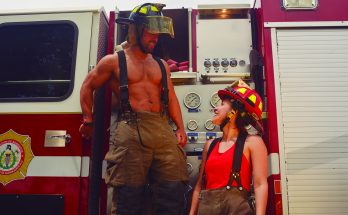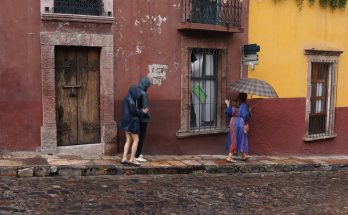By Luis Felipe Rodríguez
For most inhabitants of San Miguel de Allende, born here, neighbors, or frequent visitors to this town, the word «locos» holds a different connotation than it does for other people. For the people of San Miguel, «Los Locos» is a family spectacle in the month of June. It can be a pretext for catharsis, an outlet for those who are deviant, or an opportunity to reciprocate a favor received from Saint Anthony of Padua, the thaumaturge (considered a miracle worker). For many young people, it is daytime revelry right in the middle of the street with a captive audience.
For national and international tourists, it is a carnival. However, there are significant differences between the two. While there are masks, costumes, music, floats, and parades, the original motive and dates are different and the enthusiasm and joy do not reach the level of carnival excesses.
«Los Locos» is a religious-profane festival that allows the participants to momentarily forget about their omnipresent problems and, crossing social barriers, become equal to others while enveloped in the magic of the most outrageous disguise. Perhaps, for a few fleeting hours, they can become what they could not otherwise be (pleasant and agreeable) or forget about the social mask they have to wear in life.
In the 17th century, when San Miguel began to grow in its surroundings, some families had large orchards favored by the abundance of water in the eastern part of this town. Remnants of that time are the “pocitos,” little wells that still exist in Atascadero. The wells drilled in the city outskirts gradually depleted all those springs, including the most important one, known as «El Chorro.»
In the 18th century, San Miguel experienced the splendor of its glory. «In this century, its grand palaces and best temples are built … if independence was the reason for its name to be consigned in history, it was also the cause of its economic ruin”—Eco. De la Maza). If the truth is told, the industriousness of some Spaniards did not match the vastness of their properties, as Gabriel y Galán recounts, «… at the lazy pace of the yokes, it adjusted its languid cadences.»
The prosperity that came to San Miguel arrived in the coffers of the De la Canal family. «Don Manuel was a man of enterprise. Hardworking and wealthy. In Mexico City, where he was born in 1701, he held an important position in the government. He then decides to settle in this town shortly after marrying Doña María de Hervás, the daughter of a rich miner from Guanajuato»—Félix Luna.
In one of his writings, Father Félix Pérez de Espinosa says that indigenous people and their families worked in the orchards. Through catechesis, among other things, they learned that in Spain, the patron saint of gardeners is San Pascual Bailón, who had been in charge of the garden, the orchard, and the kitchen in his convent.
As an advanced disciple, the indigenous person immediately identified with the saint, learning, adopting, and adapting traditions. Among them is singing and dancing, whose harmonic basis rests in the small drum and the shawm (an early double-reed woodwind instrument).
To practice their dances, the gardeners wore outfits appropriate for their work. The women adorned themselves with kitchen utensils, and the men carried agricultural tools. They organized themselves into «squads,» which were formed not just of married couples but also included daughters, sons, daughters-in-law, and sons-in-law.
A mass was held for them on May 17 at the Third Order church. These squads danced in the atrium, which used to be a cemetery. After the dance, the friar would bless the fruits of the orchards. Then the gates would be opened to all the neighbors, who could eat as much fruit as they wanted but were not allowed to take it home.
The fondness for these dances grew, and two in particular, known as «Lo Hortelanos (The Gardeners)» and «El Torito (The Bull),» stood out and attracted spectators. This made it difficult for the dancing to proceed normally, so it was necessary to «protect» the dancers by inviting them to step back, expanding the circle of the audience. In this task, the elder gardeners were supported by some people dressed as scarecrows, a very common character in orchards.
Dressed in ragged clothes and leather masks and carrying quince and pear branches, they rotated within the circle, lightly tapping the feet of the spectators to prevent them from crowding the dancers. The dancers themselves were not bothered by their presence, but the children sought refuge behind the bodies of the adults they were accompanying. Sometimes the gardeners would carry stuffed animals like squirrels, badgers, aardvarks, and so on in their hands.
Although they followed the choreography, they deliberately performed their roles with grotesque movements. Combined with their outlandish appearance, they earned the nickname «locos» (the crazies). And with the cry, «Here comes the crazy one!» they would correct the territory that the spectators had encroached upon in the center of the circle. Some participants dressed as women portrayed the «old mothers» within the group of locos. These character types are known as «marotas.»
For a long time, some participants wore harlequin costumes that consisted of tight-fitting breeches, shirts with large collars, and matching cheerful colors on the left arm and right leg, and the opposite color on the other two. They still wore masks, but now they were made of wood, or later, cardboard, representing human faces. They also carried a knapsack filled with pears to give away as they passed by.
Since 1961, they have used other costumes that attracted more attention, imitating characters from films or comic strips of the time. From then on, creativity has not ceased, turning the current procession into a massive spectacle.




